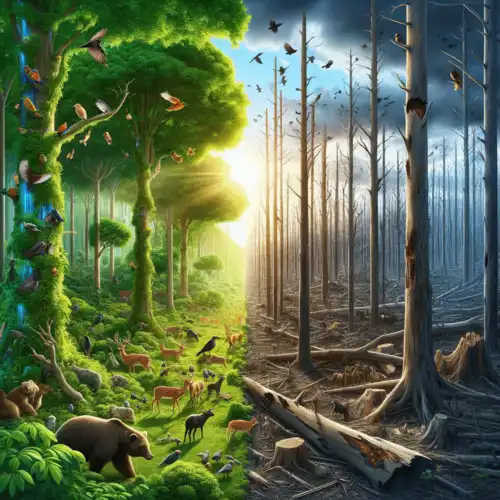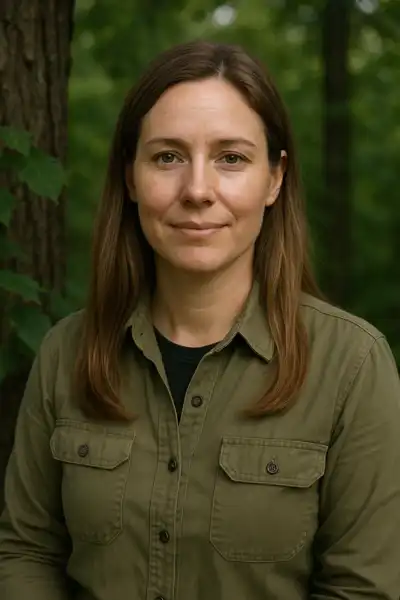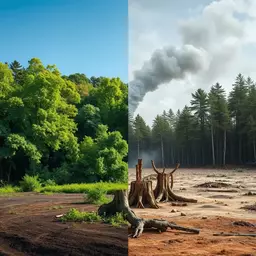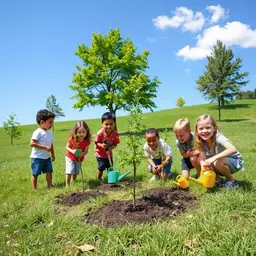Deforestation's Impact on Wildlife Habitats

What if the vibrant forests that sustain wildlife and contribute to our planet's health were to disappear before our eyes? This is not just a hypothetical scenario; it's a reality we are facing with the ongoing crisis of deforestation. Understanding its causes and impacts is pivotal for all of us who care about the environment.
What You Will Learn
- The primary causes of deforestation include agricultural expansion, urban development, illegal logging, and mining activities.
- Agricultural practices, especially monoculture farming for products like palm oil and soybeans, significantly contribute to deforestation and habitat loss.
- Habitat fragmentation, caused by development and resource extraction, isolates wildlife populations and threatens biodiversity.
- Engaging local communities and respecting Indigenous knowledge are essential for effective conservation strategies.
- Reforestation and sustainable practices are vital for restoring ecosystems and enhancing biodiversity.
- Consumer choices play a critical role; choosing sustainably sourced products can help reduce the demand for harmful practices.
- Tailored conservation strategies are necessary for addressing the unique challenges faced by different ecosystems, such as those in the Amazon and Borneo.
Deforestation Impact on Wildlife Habitats
Understanding the regional differences and the significant factors contributing to deforestation is essential for conservation strategies.
Amazon Rainforest
- Key Facts:
- - Home to countless species
- - Loss affects global oxygen levels
- - Threated by illegal logging & agriculture
Borneo
- Key Facts:
- - Home to unique species like orangutans
- - Affected by palm oil production
- - Faces illegal logging challenges
Drivers of Deforestation
- Major Causes:
- - Agricultural expansion
- - Urbanization
- - Illegal logging
- - Mining activities
Consequences of Habitat Loss
- Impact on Wildlife:
- - Increased competition for resources
- - Altered migration patterns
- - Vulnerability of endangered species
Understanding Deforestation and Its Global Impact on Wildlife Habitats
Deforestation is a pressing environmental issue that affects our planet in numerous ways, particularly when it comes to wildlife habitats. It refers to the large-scale removal of forest cover, which subsequently leads to habitat loss for countless species. As an environmentalist and tree care expert, I feel it’s crucial for us to understand the causes and global context of deforestation, not only for the trees we cherish but also for the wildlife that depend on them!
Deforestation can occur due to various activities, many of which are driven by human needs. The major causes include agricultural expansion, logging, and urban development. By recognizing these drivers, we can begin to find solutions to mitigate their impact. For instance, at Timber & Thrive, we focus on promoting sustainable tree care practices that help combat this pressing issue.
Defining Deforestation: Causes and Global Context
Understanding the broader context of deforestation is essential for grasping its implications. As forests are cleared, the delicate balance of ecosystems is disrupted, leading to dire consequences for wildlife habitats. We can identify several key factors contributing to deforestation:
- Agricultural practices, particularly monoculture farming
- Urbanization and infrastructure development
- Illegal logging and logging for commercial purposes
- Mining activities for resources
Each of these activities can lead to significant habitat degradation, which is concerning for wildlife. When we strip away forests, we also strip away the homes of countless creatures that rely on them for survival. This is a cycle we need to break!
Exploring Major Drivers of Deforestation
As we delve deeper into the factors driving deforestation, it’s important to highlight the role of agriculture. Expanding farmland, particularly for crops like soybeans and palm oil, is one of the leading causes of deforestation worldwide. These crops are often linked to unsustainable practices that not only threaten forests but also contribute to climate change.
Moreover, the demand for palm oil is a massive contributor to deforestation in regions like Southeast Asia. In fact, forests are cleared at an alarming rate to make way for palm oil plantations. As a community committed to sustainability, we can support alternatives and advocate for responsible sourcing of these products, working towards a healthier planet.
The Role of Agriculture and Palm Oil Production
Agriculture plays a significant role in deforestation, and palm oil production stands out as a prime example of this. The expansion of palm oil plantations has led to the destruction of precious rainforests, particularly in Indonesia and Malaysia. It’s important for us to be conscious consumers and understand the products we support!
- Consider purchasing sustainably sourced products to help reduce demand for unsustainable palm oil.
- Support organizations that advocate for responsible agricultural practices.
- Educate others about the environmental impact of their choices.
By making informed decisions, we can contribute to preserving these vital ecosystems for future generations. This aligns perfectly with our mission at Timber & Thrive, where we strive to promote eco-friendly practices that protect our forests and the wildlife that inhabit them.
The Crucial Link Between Deforestation and Habitat Loss
Now that we've explored the causes, it’s essential to connect the dots between deforestation and habitat loss. When forests vanish, so do the homes for countless species, which can lead to devastating effects on biodiversity. Each habitat destroyed means a significant loss of biodiversity, which is vital for healthy ecosystems.
Habitat loss can manifest in various forms, from the complete removal of forests to fragmentation, where large habitats are divided into smaller, isolated patches. This fragmentation can be just as harmful as outright deforestation, leading to the creation of “wildlife islands” that are incapable of supporting diverse animal populations. We must recognize that every action counts in the fight against this crisis!
What Does Habitat Loss Mean for Wildlife?
Habitat loss has dire consequences for wildlife. It disrupts the natural behavior and survival of species, leading to population declines. As an example, many animals struggle to find food, mates, and shelter when their habitats are destroyed. This is not just a statistic; it represents a loss of life and the fabric of our ecosystems!
- Animals may face increased competition for dwindling resources.
- Migration patterns can be altered, making it hard for animals to find new habitats.
- Endangered species can become even more vulnerable, leading to extinction.
As we move forward, it’s crucial that we take these effects seriously and work collectively to strengthen conservation efforts. After all, our forests are not just home to trees; they are vibrant ecosystems that need our protection.
The Mechanism of Habitat Fragmentation and Its Impact
Habitat fragmentation occurs when large, continuous habitats are broken into smaller, isolated patches. This can happen due to roads, urban development, or agricultural practices. Fragmentation can isolate animal populations, making it increasingly difficult for species to thrive. Think of it as cutting a tree into pieces and expecting each piece to continue growing!
The effects of fragmentation are profound. Wildlife corridors, which allow animals to move between habitats, become obstructed, limiting genetic diversity and the overall health of species. This situation highlights the urgency for us to promote sustainable practices that maintain the integrity of these habitats.
Forest Fragmentation: Consequences for Wildlife Corridors
Wildlife corridors are crucial for maintaining biodiversity, but deforestation and fragmentation can sever these connections. When animals can't migrate or find mates, their populations decline, which can lead to local extinction. It’s heartbreaking to think about the future of species who may vanish simply because we didn’t take action!
- Loss of genetic diversity can make populations more vulnerable to disease.
- Increased mortality rates due to inability to find food or mates.
- Declining populations can upset the balance of local ecosystems.
At Timber & Thrive, we believe that by understanding these impacts, we can take meaningful steps toward preserving our forests and the wildlife they support. Together, we can create a brighter future—one where trees and wildlife thrive in harmony!
Pro Tip
Did you know that choosing sustainable products can significantly impact deforestation rates? By opting for items certified by organizations like the Rainforest Alliance or Fair Trade, you support responsible sourcing practices that protect vital ecosystems and wildlife habitats. Every purchase you make is a vote for the kind of world you want to see!
Addressing Content Gaps: Regional Differences in Deforestation Impact
Understanding the differences in how deforestation affects various ecosystems is essential for formulating targeted conservation strategies. Each region presents unique challenges and opportunities in the fight against habitat loss. For instance, the Amazon rainforest, often referred to as the "lungs of the Earth," is facing deforestation at an alarming rate. Here, the interdependence of species and the overall health of the ecosystem are critically at risk.
In contrast, Borneo, with its rich biodiversity, presents its own set of challenges. Factors such as palm oil production and illegal logging threaten not just the habitats but also the indigenous communities that depend on these forests. By drawing attention to these regional differences, we can better tailor our conservation efforts and make a more significant impact on preserving wildlife habitats.
Comparative Analysis of Deforestation in Various Ecosystems
When we compare the Amazon rainforest and Borneo, it's clear that both regions are vital to global biodiversity. The types of species, the ecosystems' functions, and even the socio-economic contexts differ significantly. Recognizing these differences is crucial for effective conservation efforts.
- Amazon Rainforest: A hub for countless species, its loss affects global oxygen levels and carbon storage.
- Borneo: Home to unique species like orangutans, it faces pressures from palm oil production and deforestation.
As I reflect on these regions, it becomes evident that a one-size-fits-all approach does not work. Each ecosystem requires tailored strategies that account for its unique characteristics and challenges.
Amazon Rainforest: A Global Biodiversity Hotspot
The Amazon rainforest is a critical component of our planet’s ecosystem. It houses an incredible diversity of wildlife, but continuous deforestation is leading to significant habitat loss. Have you ever imagined what life would be like without the rich biodiversity that the Amazon offers? It’s not just about the trees; it’s about all the creatures, big and small, that depend on them.
Some key threats to the Amazon include:
- Illegal logging and land clearance for agriculture
- Infrastructure development
- Mining activities
These threats not only disrupt the ecosystem but also affect the global climate, showcasing the interconnectedness of our world.
Borneo: The Unique Challenges of Southeast Asia
Borneo’s ecosystem is astounding, but it faces unique challenges that are different from those in the Amazon. The island is often regarded as one of the most biodiverse places on Earth, yet its forests are disappearing rapidly. This loss affects not just the wildlife but also the local communities who rely on the forests for their livelihoods.
Some challenges include:
- Deforestation for palm oil plantations
- Forest fires and illegal logging
- Fragmentation of habitats due to land development
Understanding these challenges can help organizations like Timber & Thrive develop effective strategies to protect these vital ecosystems.
Mitigation Strategies and Conservation Efforts
As we explore ways to combat deforestation, it’s essential to look at successful strategies in various regions. These mitigation efforts are critical in addressing the unique challenges posed by different ecosystems. At Timber & Thrive, we believe in the power of community engagement and education to drive change.
- Highlighting Successful Conservation Projects: Initiatives that involve local communities often see the best results.
- Promoting Sustainable Practices: Encouraging consumers and corporations to adopt eco-friendly choices can significantly reduce deforestation pressures.
- Wildlife Conservation Initiatives: Engaging Indigenous peoples in conservation efforts ensures that their knowledge and needs are respected.
- Reforestation: Planting trees is a powerful tool for restoring biodiversity and improving ecosystems.
These strategies not only help protect wildlife but also foster a sense of stewardship within communities. Wouldn’t it be wonderful to see more people engaging in these vital efforts?
Highlighting Successful Conservation Projects
Success stories in conservation can inspire hope and drive action. Projects that integrate local knowledge with scientific research often yield impressive results. For example, in the Amazon, initiatives that empower local communities to manage their resources sustainably have shown promise. By restoring damaged areas and promoting sustainable forestry practices, these projects can help revitalize ecosystems.
Moreover, in Borneo, organizations have focused on preserving orangutan habitats while simultaneously supporting local communities' livelihoods. When conservation efforts align with the needs of people, everyone wins!
Promoting Sustainable Practices Among Consumers and Corporations
One of the most impactful ways to combat deforestation is through informed consumer choices. By choosing sustainably sourced products, we can directly support eco-friendly practices. At Timber & Thrive, we encourage everyone to:
- Research product origins
- Support brands committed to sustainable practices
- Advocate for transparency in supply chains
When consumers demand change, corporations often follow suit. Together, we can influence markets for the better!
Wildlife Conservation Initiatives: Engaging Indigenous Peoples
Indigenous communities have a wealth of knowledge regarding their local ecosystems. Their involvement in conservation can lead to more effective and culturally relevant strategies. By collaborating with these communities, conservation initiatives can ensure that traditional practices are honored and integrated into modern efforts.
Emphasizing their role not only supports biodiversity but also respects their rights and heritage. Isn’t it amazing how working together can yield such powerful outcomes?
Reforestation and Its Role in Biodiversity Recovery
Reforestation is vital for restoring habitats and enhancing biodiversity. Planting trees helps to recreate the complex ecosystems that were lost due to deforestation. It’s about more than just planting; it’s about nurturing these new forests to thrive.
Here are some frequently asked questions about deforestation and its impact:
- What are the main causes of deforestation?
- The primary causes include agricultural expansion, urban development, illegal logging, and mining activities.
- How does agriculture contribute to deforestation?
- Agricultural practices, especially monoculture farming for products like palm oil and soybeans, significantly contribute to deforestation and habitat loss.
- What is habitat fragmentation and why is it harmful?
- Habitat fragmentation, caused by development and resource extraction, isolates wildlife populations and threatens biodiversity.
- Why is it important to engage local communities in conservation efforts?
- Engaging local communities and respecting Indigenous knowledge are essential for effective conservation strategies.
- What role does reforestation play in combating deforestation?
- Reforestation and sustainable practices are vital for restoring ecosystems and enhancing biodiversity.
- How can consumers help reduce deforestation?
- Consumer choices play a critical role; choosing sustainably sourced products can help reduce the demand for harmful practices.
- Why are tailored conservation strategies necessary?
- Tailored conservation strategies are necessary for addressing the unique challenges faced by different ecosystems, such as those in the Amazon and Borneo.
Some important benefits of reforestation include:
- Restoring wildlife habitats
- Improving soil health
- Enhancing carbon sequestration
Being involved in reforestation projects can be incredibly rewarding. I encourage everyone to seek out local initiatives or get involved in community tree-planting events!
Summary of Key Insights and Steps Forward
As we wrap up our discussion, it’s clear that understanding the regional differences in deforestation impacts is crucial for effective conservation. By recognizing unique challenges and implementing tailored strategies, we can better support the ecosystems that are under threat. Remember, every action counts, no matter how small. Together, we can make a difference! Did you know deforestation has significant effects on local ecosystems?
Recapping the Effects of Deforestation on Wildlife Habitats
Deforestation has profound effects on wildlife habitats, leading to a loss of biodiversity and disrupted ecosystems. As we’ve explored, different regions face unique challenges that require focused strategies. By acknowledging these differences, we can enhance our conservation efforts and pave the way for more sustainable practices.
Encouraging Action: How Individuals Can Make a Difference
Each of us has the power to contribute to the fight against deforestation. Whether through supporting sustainable products, participating in local conservation efforts, or educating others, every little bit helps. I invite you to reflect on what steps you can take to support our planet’s vital ecosystems. Let’s work together for a greener, healthier future!
Recap of Key Points
Here is a quick recap of the important points discussed in the article:
- Deforestation is caused primarily by agricultural expansion, urbanization, illegal logging, and mining activities, leading to significant habitat loss for wildlife.
- The demand for products like palm oil drives deforestation, particularly in regions like Southeast Asia, emphasizing the need for sustainable sourcing.
- Habitat fragmentation disrupts wildlife corridors, making it difficult for animal populations to thrive and leading to a loss of biodiversity.
- Regional differences in deforestation impacts, such as those seen in the Amazon and Borneo, highlight the need for tailored conservation strategies.
- Engaging local communities and promoting sustainable practices are crucial for effective conservation and mitigating the effects of deforestation.
- Reforestation efforts are vital for restoring habitats and improving biodiversity, showcasing the importance of community involvement in these initiatives.



